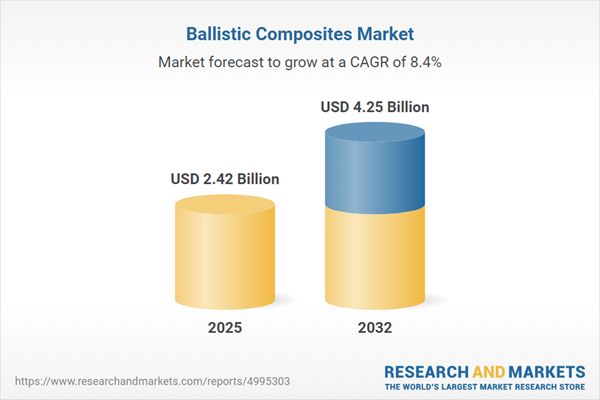Speak directly to the analyst to clarify any post sales queries you may have.
The ballistic composites market is undergoing rapid evolution as organizations in defense and commercial sectors seek advanced, adaptive materials that address stringent safety, regulatory, and operational requirements. Senior decision-makers are prioritizing protective solutions that offer compliance, flexibility, and consistent supply chain responsiveness.
Market Snapshot: Ballistic Composites Market Growth and Outlook
The ballistic composites market is valued at USD 2.22 billion in 2024, with expectations to reach USD 2.42 billion by 2025 and USD 4.25 billion by 2032, indicating a CAGR of 8.41% across the forecast period. This upward trend is propelled by expanding adoption of high-performance protective materials in both mature defense markets and newly emerging commercial applications. Innovation in fiber and matrix technologies continues to allow for lighter, stronger, and more versatile solutions, making it possible for a greater number of industries to implement next-generation ballistic protection. Suppliers are responding by strengthening customization capabilities, enhancing value chain partnerships, and optimizing offerings to support clients managing new certification frameworks and operational demands.
Scope & Segmentation: Strategic Priorities in the Ballistic Composites Market
A thorough understanding of the ballistic composites market’s structure enables leadership to refine procurement strategies and strengthen organizational resilience. Tailoring investments by material type, application, product form, and regional needs allows companies to remain agile amid shifting standards and threat landscapes.
- Material Types: Aramid fibers, in both woven and non-woven formats, are chosen for their flexible defensive profiles, accommodating complex threats. Carbon fiber and ceramic matrix composites supply a critical combination of low weight and high mechanical strength suitable for mission-critical use. S2 glass fibers are valued by organizations requiring reliable durability in challenging operating conditions.
- Application Segments: Ballistic composites are integrated into body armor, helmets, shields, vehicles, aircraft, and increasingly serve civilian protection and non-tactical sectors, supporting a range of operational risk scenarios.
- End-Use Industries: The majority of uptake resides within defense and law enforcement, yet there is mounting interest from commercial, industrial, and personal protection industries seeking solutions for emerging and unconventional security requirements.
- Product Forms: Coatings, laminates, panels, and sheets provide adaptability for diverse equipment needs, contributing to simplified maintenance routines and flexible deployment options that align with evolving operational objectives.
- Regional Markets: In the Americas, procurement is strongly influenced by risk management strategies and compliance alignment. EMEA markets reflect rapid modernization under new standards, while Asia-Pacific demonstrates continuous expansion, driven by ongoing industrialization and regional collaboration initiatives.
- Key Companies Analyzed: The evaluation covers Honeywell International Inc., Teijin Limited, Koninklijke DSM N.V., and Toray Industries Inc., who are recognized for technological leadership, diversified portfolios, and reliability as solution partners.
Key Takeaways: Strategic Insights for Senior Decision-Makers
- Modern ballistic composites help organizations customize protection to accommodate changing threat environments and stringent compliance landscapes, elevating safety and policy responsiveness.
- Stakeholder collaboration between manufacturers, end-users, and technical teams is accelerating the adoption of advanced composites for both traditional and emerging uses worldwide.
- Industry-wide progress toward standardized certification processes is strengthening supplier relationships and building continuity and trust across supply partnerships.
- Robust supplier networks and precision in sourcing strategies enhance operational resilience, enabling organizations to navigate disruption in procurement or logistics with minimal impact.
- Innovative development of recyclable and bio-based materials positions organizations to manage lifecycle requirements and meet emerging regulatory initiatives.
- Wider adoption of digital asset management supports transparent resource allocation and streamlined oversight for protective assets, reinforcing enterprise-wide readiness.
Tariff Impact: Influence on Supply Chains and Cost Structures
Recent U.S. tariff adjustments on imported composite fibers have encouraged local manufacturing collaborations, contributing to supply chain stability for key ballistic materials. These measures support improved sourcing reliability while lessening the impact of global logistics fluctuations and changing trade policy environments.
Methodology & Data Sources
This analysis is informed by direct interviews with composite material specialists and a review of primary market research sources. Validation by defense procurement professionals ensures the data and insights are robust, credible, and actionable for executive decision-making and procurement strategy.
Why This Ballistic Composites Report Matters
- Provides executive teams with targeted market analysis to enable optimized procurement strategies and effective risk management aligned with current compliance expectations.
- Delivers actionable insights on supplier landscapes, supporting market entry or expansion across steadily evolving regions and sectors.
- Spotlights sustainability-driven trends, helping organizations to anticipate regulatory changes and prioritize investments in long-term asset solutions.
Conclusion
Ballistic composites play an increasingly critical role in safeguarding assets and people across both defense and commercial applications. Senior leaders equipped with strategic market intelligence are positioned to drive adaptive, compliant security strategies in a dynamic operating environment.
Additional Product Information:
- Purchase of this report includes 1 year online access with quarterly updates.
- This report can be updated on request. Please contact our Customer Experience team using the Ask a Question widget on our website.
Table of Contents
3. Executive Summary
4. Market Overview
7. Cumulative Impact of Artificial Intelligence 2025
Companies Mentioned
The companies profiled in this Ballistic Composites market report include:- Honeywell International Inc.
- Teijin Limited
- Koninklijke DSM N.V.
- Toray Industries, Inc.
- Solvay S.A.
- Hexcel Corporation
- SGL Carbon SE
- Mitsubishi Chemical Corporation
- DuPont de Nemours, Inc.
- DSM-Firmenich AG
Table Information
| Report Attribute | Details |
|---|---|
| No. of Pages | 198 |
| Published | October 2025 |
| Forecast Period | 2025 - 2032 |
| Estimated Market Value ( USD | $ 2.42 Billion |
| Forecasted Market Value ( USD | $ 4.25 Billion |
| Compound Annual Growth Rate | 8.4% |
| Regions Covered | Global |
| No. of Companies Mentioned | 11 |









